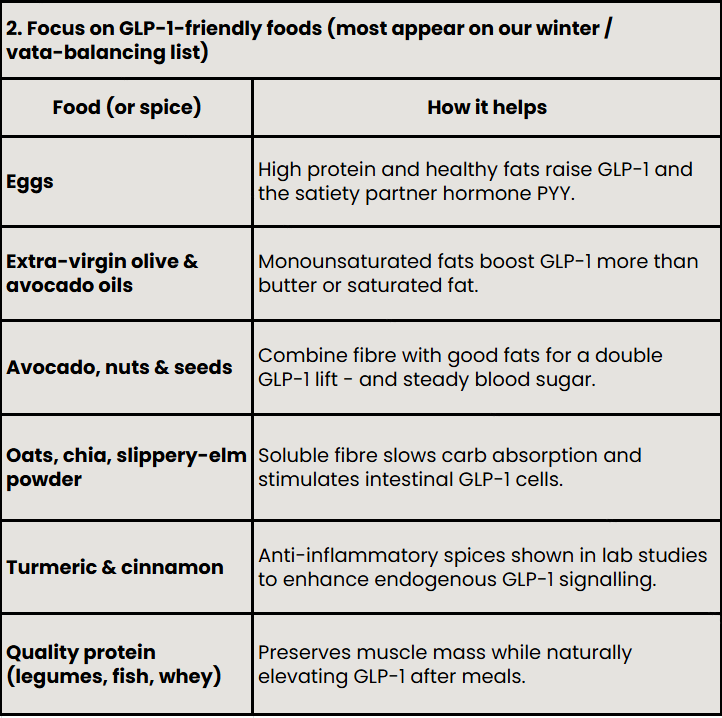Why Quick-Fix Weight-Loss Drugs Can Cost You Far More Than the Price Tag
Why Quick-Fix Weight-Loss Drugs Can Cost You Far More Than the Price Tag
Find out how an Ayurvedic approach boosts your GLP-1, naturally
You’ve probably heard the buzz around Ozempic® or Mounjaro and other GLP-1 agonist injections. Yes, they can nudge the scale, but the hidden bill includes steep pharmacy costs, medication shortages, and side-effects that may linger long after the kilos have gone.
The science in a nutshell
- GLP-1 (glucagon-like peptide 1) is a satiety hormone made in the gut. It prompts the pancreas to release insulin, slows stomach emptying and tells the brain you’re full.
Ozempic® (semaglutide) mimics this hormone. It works but at a price: nausea, vomiting, diarrhoea, constipation and even pancreatitis or eye changes are all on the official list


Ayurveda’s longer game: lift GLP-1 from the inside out
Ayurveda frames stubborn weight and erratic blood sugar as a vata-provoked stress response: when the nervous system is in overdrive, we crave quick fuel and store fat. Calming that stress is step one.
- De-stress the gut–brain axis
- 5-minute morning meditation or slow nasal breathing regulates the vagus nerve, a direct pathway to GLP-1 release and better appetite control.
- Eat seated, without screens, and finish when 80 % full. Your vagus nerve needs about 20 minutes to say “I’m satisfied.”

- Eat with the sun
- Big, leisurely midday meal when digestion is strongest.
- Light dinner before 6 pm, or soup only. This overnight “mini-fast” nudges the body to burn stored fat instead of raiding the fridge.
- Move intentionally
Strength work two to three times a week protects lean tissue, something the injections can’t promise.
Your next step:
At Health Dynamics we marry these timeless principles with modern diagnostics. Rather than chasing symptoms, we:
- Measure: Are your blood pathology up to date. A comprehensive blood & body-composition scan.
- Reset: We suggest one detox per year. A guided seasonal detox to calm vata, which causes stress and clear digestive fire.
- Rebuild: Personalised nutrition, herbs, and mindset coaching so habits stick.
Our NEXT Detox kicks off 29th September; spots fill fast. If you’re ready for change that compounds not backfires—reply “DETOX” to this email or book a clarity call. Or check out the detox here
“When you work with your body, not against it, the results may be slower—but they’re sustainable, and the side-effects are called health.” – Jo Formosa
Below are ball-park annual price-tags Australians face once one of the “four horsemen”, Heart disease, Cancer, Diabetes or Alzheimer’s, is diagnosed.
Figures come from the most recent national costing studies, which vary by age, severity, and private versus public care, but provide a clear sense of scale.
Quick fixes fade—wisdom lasts. Choose the path that pays dividends for decades, not just weeks.

The take-away
- Prevention is the bargain. Investing $997 in a professionally guided detox + root-cause testing is less than one-quarter of a single year’s diabetes bill and barely a blip against first-year cancer costs.
- Quick fixes feel cheap up-front but expensive later. A $200 – $600/month weight-loss injection, for example, totals $2,400-6000 in a year already approaching the annual health-system spend for heart disease per patient, with no guarantee you’ll keep the weight off (or avoid side-effects).
- Some damage isn’t reversible. Muscle loss after crash diets, nerve damage from poorly controlled diabetes, or cognitive decline post-stroke can’t be “refunded.”
Bottom line: saying “I can’t afford prevention” often means agreeing silently to write much bigger cheques to doctors, pharmacists and hospitals down the track. A proactive plan that tackles stress, gut health and lifestyle drivers is the cheapest “insurance” you’ll ever buy.
HERE is the real LESSON:
Most of us postpone real change because it demands effort, trading old comforts for new habits, facing the awkward moment when everyone else orders another round, and, hardest of all, sitting with the emotions we once drowned in food, alcohol or mindless scrolling. Yet the “ease” of doing nothing is an illusion. When lifestyle debt matures into disease, the bills, doctor visits, lost independence, and endless care don’t fall only on us; they land on the shoulders of those we love. Remember:
“Your lack of responsibility now will become someone’s responsibility later.”
A yearly detox and data check keeps that responsibility firmly in your hands—methodically, compassionately, and for life.


Responses